A well-designed bathroom is one that creates the mood you want and has the features you desire. With the right colors and materials, even a small bathroom can feel luxurious.
To design your bathroom remodel or new bathroom, think about who will use the room and identify the “must have” and “nice to have” features. Then determine the “look” you want by creating a “mood board” with photos of styles and samples of colors that catch your eye. Consider how the style and colors will blend with adjoining rooms or hallways.
You can keep a consistent design between the bathroom, bedroom and closet, by using the same color scheme or a complementary color scheme and hardware finishes.
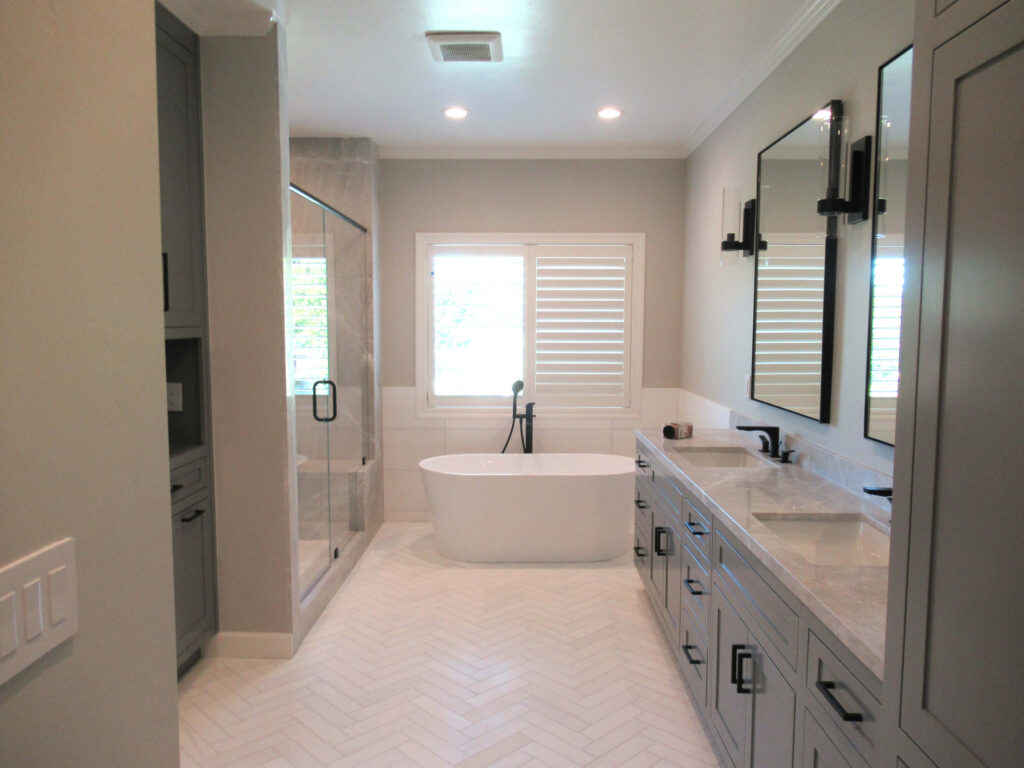
Design Recommendations
- In designing a bathroom adjacent to a bedroom, think about the layout of your bedroom and closet(s). Do you want the bathroom and closet to be connected? Do you mind walking through your bedroom to get to the bathroom? Are all the bathroom users on the same schedule? Does someone shower and get dressed while another is still sleeping?
- If the bathroom will have multiple users at the same time, include double sinks, plenty of counter space, separate storage areas for each person’s toiletries, a large shower, and a private toilet area.
- If you are doing a bathroom remodel and want to change the location of sinks, shower, or tubs, talk with your bathroom remodeling contractor about how the change will work with existing plumbing.
- Choose cabinets that provide a hamper for dirty clothes and dedicated storage space for linens, toiletries, hairdryers and other electric items.
- Whenever possible, use natural materials such as stone, wood and plants to balance water elements and create a relaxing, spa-like atmosphere.
- Choose tub and shower surrounds, backsplashes, and floor coverings with neutral colors and patterns that won’t look outdated in a few years.
- Choose a neutral wall color (white, gray, tan, beige) that compliments the countertop and cabinets. (Test the color at different times of day, as lighting can affect how the color will look.)
- Choose traditional cabinet colors (e.g. natural wood, white, gray, white oak, or espresso) as opposed to bold and trendy colors (e.g., pink, navy blue, forest green).
- Choose high-quality fixtures in classic finishes (e.g., chrome, brushed nickel, black, pewter, oil rubbed bronze or brass)rather than bold and trendy colors, and use the same finish throughout your master bath, bedroom and closet.
- Add pops of color with linens, decorative items and other easily changeable accents.
- Include an unexpected focal point that is relaxing or eye-catching. It might be a decorative light, a dramatic vanity, a unique work of art, a graphic floor design, or a unique wall treatment that compliments the mood of the bathroom.
- If you like to listen to the news, music, or podcasts while you are in your bathroom, add a built-in stereo system or a built-in television. You can disguise these as architectural elements or embed the TV into the bathroom mirror.
Bathroom Shower
In designing a new shower or a shower remodel, think about which of the following you prefer:
- A small, functional shower or a large spa-like shower?
- A curb-less, open shower or an enclosed shower?
- A shower and tub combo or a separate tub and shower?
- A sauna or steam shower?
Contractor Recommendations:
- Enclose your shower rather than leaving it open. Open showers look attractive but don’t hold in heat and can be drafty. Plus, a glass shower door will make the bathroom look larger.
- In a tub/shower combo, a glass door that extends halfway across the tub is adequate for most people. Two sliding doors that close completely are not necessary. For a modern look, choose shower door hinges that are high in quality and minimalist in design.
- If you are concerned about the glass doors spotting or about the skin-drying effects of chloramine or chloramine that is used to treat city water, consider installing a water filtration system and/ or central water softener in your home.
- Think carefully about where you want to have the shower head located. It should be high enough to accommodate the tallest user and adjustable down to accommodate shorter users.
- To avoid getting sprayed with cold water when you enter the shower, place shower controls on the wall that is opposite the showerhead. If you are doing a remodel, this will add some extra expense, but it’s a feature you will appreciate.
- To design a shower niche in which you can store shower items, take inventory and measurements of the products that you typically keep in the shower. Use the top shelf for the tallest items (such as shampoo), the middle shelf for shorter ones, and the thin bottom shelf for items such razors and soap.
- In lieu of a built-in niche, install stone or high-quality, corrosion-resistant brass corner shelves (such as those made by Samuel Heath) to hold toiletries.
- No bathroom tub or shower should be without a hand-held sprayer. A sprayer is great for cleaning shower walls, rinsing shaved legs, cleaning pets, and more.
- The pros suggest forgoing a steam shower unless you have space to create a dedicated steam room, as the costs of installation and upkeep can be high.
- To make soaping up or shaving your legs safer, install a shower ledge on which you can sit to do these tasks.
- If you will be installing tile or stone slab as the shower surround, extend it to the ceiling or at least to 12 inches above the showerhead.
- Hire an experienced licensed tile setter to install the tile to ensure even grout lines and a pleasing pattern. Tiles installed without thought and planning can ruin the look of the room.
Bathroom Tub
If you plan on having a tub in your bathroom, the best way to find one that will work for you is to visit bathroom showrooms and sit in several tubs.
In choosing a tub you will need to decide the following:
- Freestanding or built in?
- Made of porcelain, acrylic, cast-iron, copper or brass?
- How long, wide, and deep?
- Whirlpool?
Contractor Recommendations:
- When choosing a material for your tub, consider scratch resistance and chip resistance, as well as retention of heat. Acrylic and porcelain tubs are the most popular, but they can scratch and chip when heavy objects fall into them. Metal tubs such as cast iron, copper and brass retain heat from bathwater longer than acrylic or porcelain tubs.
- If you want to tile or put stone slab on the facing of your tub, make sure that the tub you choose will allow that.
- Think carefully before choosing a whirlpool tub as the costs of installation and upkeep are high and often such tubs are seldom used after the initial novelty wears off.
- Whether your bathroom tub is freestanding or sunken, consider models that have a wide rim on which you can sit and rest bath accessories or candles.
- If you want a tub/shower combo, think carefully about where you want to have the tub controls located. The tub flow and temperature controls should be low enough that a person sitting in the tub can reach them easily. All controls and faucets should be evenly aligned. Don’t leave these details up to your contractor. Show your bathroom contractor exactly where you would like the controls to be located.
- If you decide not to have a tub but have extra space in your bathroom, consider having a licensed contractor install rough-in plumbing so that future inhabitants can easily install a tub. This is a plus for resale value.
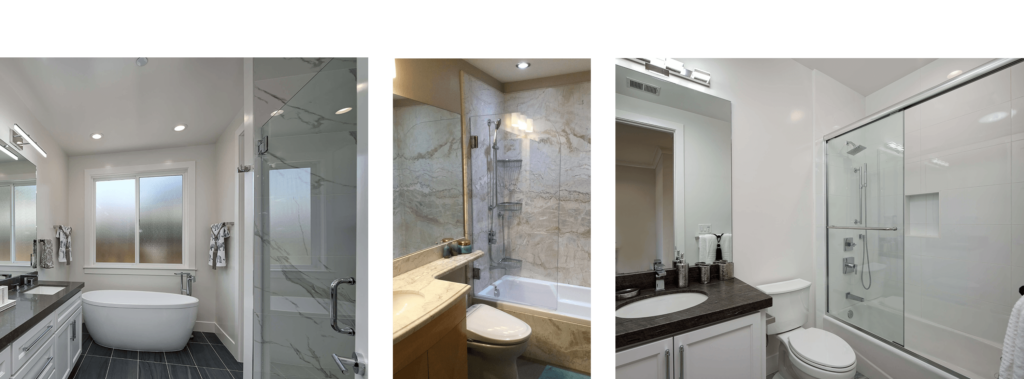
Bathroom Sink
Bathroom sinks are available in a wide variety of styles, colors and materials. When choosing a single sink or double sinks, consider the size, style, ease of cleaning, and resistance to scratching, chipping and staining.
Designer Recommendations:
- Is the sink deep enough to allow you to hand-wash delicate items without water splashing out?
- Does the size allow sufficient counter space on both sides?
- Does the depth of the sink leave sufficient counter space between it and the wall behind to allow installation of the faucet that you have in mind?
- Do you prefer an Undermount Sink? It will give a sleek, modern look with no rim visible on the counter and will allow easy counter cleaning.
- Do you prefer a Drop-in Sink? This style is more difficult to clean around and is becoming less popular in high-end bathrooms.
- Do you prefer a Countertop Sink that sits on the counter and serves as a design element or focal point of the room?
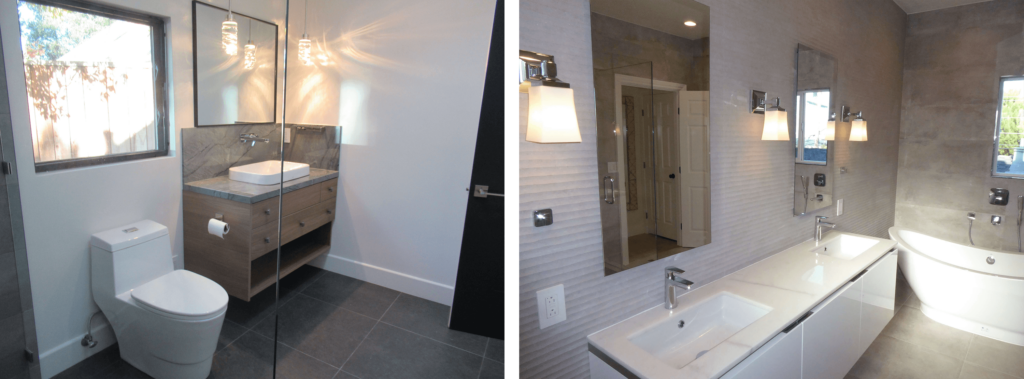
Bathroom Fixtures and Accessories
The bathroom fixtures and accessories are the “jewelry” of the bathroom. Take your time to choose hardware that you enjoy seeing and touching. Ascertain that it is high quality and durable, and that it will not peel, pit, tarnish, dent or break.
Designer Recommendations:
- When choosing styles and finishes for bathroom hardware, coordinate all the following:
- Sink and Tub Faucets
- Shower Knobs, Rods, Shower Head
- Hand-held Shower
- Sink and Tub Stoppers
- Wall Hooks for Robes
- Loop or Hook for Hand Towel
- Cabinet Door and Drawer Pulls
- Towel Bars
- Towel Warmer
- Magnifying Mirror
- Wall Covers for Electric Switches and Outlets
- Keep in mind that finding products with matching colors or finishes can be a challenge. For example, the color of “chrome” or “brushed nickel” finish from one manufacturer might be different from “chrome” or brushed nickel” finish from other manufacturers.
- Plan ahead regarding sink and tub drain stoppers if you want them to match the other fixtures in your bathroom, as the ones that come with the sink or tub might not be a finish that matches your other fixtures so you will need to order alternatives and have them available before your tub or sink are installed.
- For accessories such as towel bars and cabinet and drawer pulls, choose styles and sizes that complement the look of the bathroom.
- If applicable, have family members test cabinet and drawer pulls to see if larger hands easily slide into the drawer pulls and if arthritic fingers can easily grab knobs or handles,
Bathroom Sink Faucet
The main considerations when choosing a bathroom sink faucet are style, operation, finish, and quality.
Operation Options:
- Turn two knobs – Attractive but less convenient than a single lever
- Move a lever – Useful when your hands are dirty
- Touch activated – Convenient, except when you didn’t really mean to turn the water on
- Touchless – Convenient, except when you didn’t really mean to turn the water on
Contractor Recommendations:
- Visit a faucet showroom where you can touch and operate a variety of faucets.
- Choose a finish that will wear well. Chrome is the most popular and the most economical. Brushed nickel, brass, bronze, stainless steel, matte black and custom are also options.
- Look for a high-end finish that “pops” and feels luxurious when you hold the faucet.
- When choosing products from different manufacturers, compare the finishes carefully if you want them to be identical, as finishes of the same name are not always the same color.
- Look for stainless steel or solid brass construction. (Be suspicious if the manufacturer does not disclose the materials. “Brass construction” likely means that the faucet is brass-plated zinc or steel rather than solid brass.)
- Look for a seamless, one-piece design.
- Look for warranties on parts and finish that are comprehensive and that do not require submission of the original receipt to obtain replacement parts.
- Check the clearance that you need behind the faucet as larger faucets might require more clearance than you have available if your sink is large and the countertop is narrow.
- Opt for quality faucets and plumbing fixtures. Choose them based on the quality of their inner components as well as their outer look and function. Avoid faucets that have plastic parts, as these can break down rapidly.
- When deciding what faucets and fixtures to buy, it is advisable to read numerous reviews from customers who have used those fixtures and faucets.

Bathroom Toilet
Toilets are not what they used to be. Technology has made new options possible: self-cleaning, heated seats, bidet functions, integrated air dryer, personal memory settings, and even music and atmospheric lighting.
Contractor Recommendations:
- Visit bathroom showrooms and sit on a variety of toilets to find the one that feels most comfortable.
- Consider height. If anyone in your home has mobility issues, a higher toilet might be more comfortable than a lower one.
- Decide if you prefer a round or elongated design.
- Look at the underside of the toilet and notice where dust might collect. Some styles have smooth sides rather than dust-collecting ledges.
- To create a modern, European look, consider a wall-mount toilet.
- If you prefer not to go with a high-tech model, at a minimum, choose a soft-close lid.
- If you have the space, place the toilet behind a pocket door or half-wall to provide extra privacy.
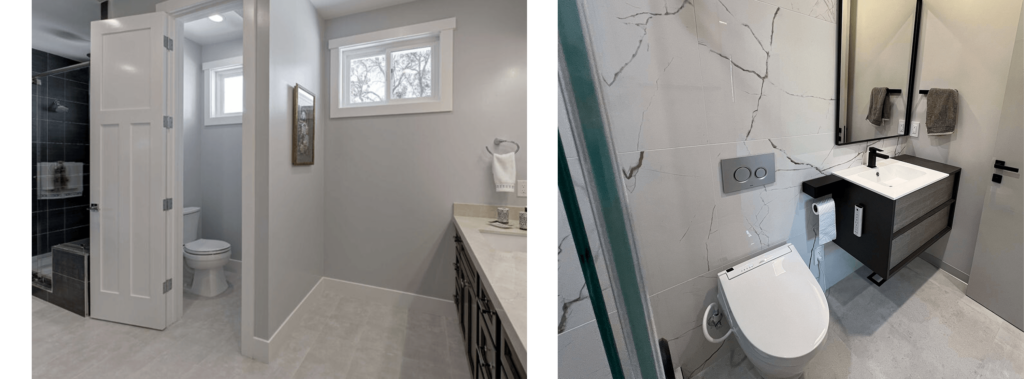
Bathroom Towel Warmer
A welcome addition to any size bathroom is a heated, wall-mounted towel rack that will dry your towels quickly and prevent a musty odor. Many shapes and styles are available and most require a dedicated 220-volt outlet. Your licensed bathroom remodeling contractor or building contractor can install this for you. Research various brands and choose the best quality you can afford.
Bathroom Vanity and Storage Cabinets
Features to look for in bathroom vanity and storage cabinets include the following:
- A pullout shelf or drawer for a hair dryer (with a hole in the back for the cord and an electric outlet on the wall behind)
- A pullout or shelves for storing linens
- Pullout or shelves and drawer for storing personal care products
- A space for trash and toilet paper storage
- A hidden hamper
- All-plywood construction
- Soft-close hinges on doors
- Soft-close, full-extension, steel, under-mount drawer glides
- Hardwood dove-tail drawer boxes
- Humidity resistant material and finish, as moisture can damage the surface over time
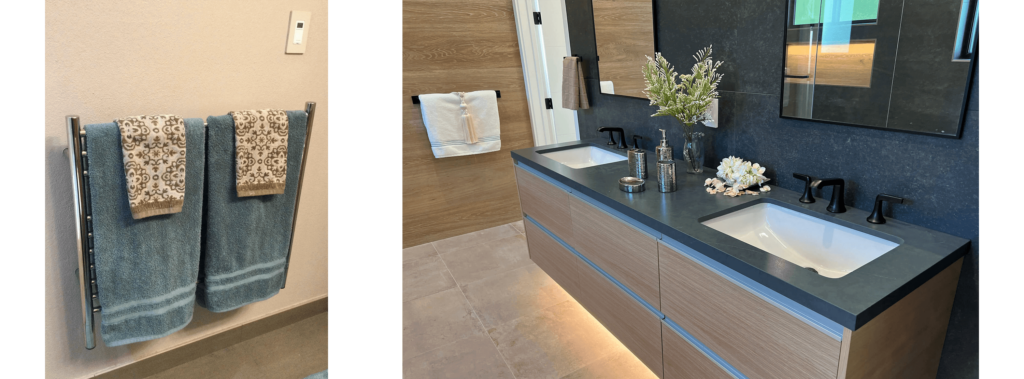
Bathroom Countertops and Backsplashes
If you prefer a uniform look, you can choose a countertop and backsplash of the same material. If you prefer to create contrast you can use complementary materials, colors and patterns. When choosing countertop and backsplash material, consider stain and scratch resistance, ease of daily care and requirements for long-term maintenance.
Contractor Recommendations
- Natural stone slabs such as marble, granite and quartzite can look elegant and pass the test of time. Natural stones are porous – containing tiny holes that allow liquids, air, and bacteria to penetrate – and they can stain or darken if not properly sealed. Make sure that your licensed contractor uses a professional sealant and inquire about how often the materials should be re-sealed.
- Manufactured surfaces such as recycled glass, Cambria, DuPont Corian, and DuPont Zodiaq (engineered quartz) are non-porous. They will not harbor mold or bacteria and do not require sealing.
- When choosing edging (known as “bullnosing”) for the countertops, choose a style (rounded, straight, etc.) and height (one to three inches of “overhang”) that complement the style of your cabinets and stonework.
- In a small bathroom with the toilet located next to the vanity, you can create more counter space by extending the length of the countertop from over the vanity in a “banjo” shape over the top of the toilet. Just be sure that there is enough clearance between the top of the toilet and the bottom of the countertop to allow toilet repairs. Also ask your remodeling contractor about how they plan to finish off the underside of the countertop above the toilet. You don’t want to be relaxing in the tub and look at an unfinished underside of the countertop.
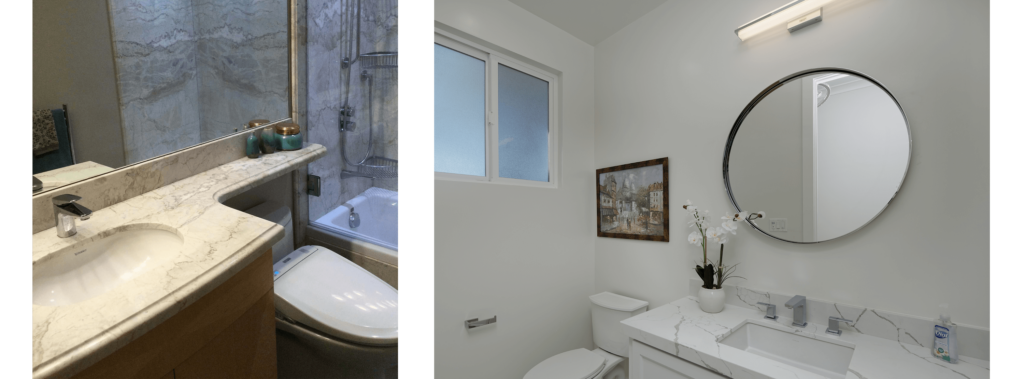
Bathroom Flooring
Common bathroom flooring materials include natural stone (especially marble and slate), porcelain tile, ceramic tile or concrete.
Contractor Recommendations
- When choosing flooring, consider the material, color, pattern, finish, size, shape, hardness, slip factor, ease of cleaning and the likelihood of damage if water spills or a heavy item falls onto it.
- If choosing natural stone tiles, determine how porous the stone is and make sure that your bathroom contractor seals them with a professional sealant.
- If choosing ceramic tiles, determine if the color and design permeate the entire tile or if they are only on the surface. (Avoid the latter.) Choose good-quality tile that is at least a quarter inch (ten millimeters) thick.
- Consider porcelain tile. The color extends throughout the tile, it is moisture resistant, and it is more durable than ceramic tile.
- If flooring will be installed on top of a concrete slab or near water, make sure that the installers seal any cracks in the concrete and do a moisture check. Moisture under the flooring can cause hardwood to warp, natural stone to change color, and grout to flake, chip or discolor. (Keep in mind that a moisture check done in dry season might yield a false negative.) Paying a bit extra to have a moisture barrier installed under flooring can prevent unpleasant surprises in the future.
- To avoid the shock of stepping onto a cold tile floor with bare feet, consider installing radiant heat. It can be installed using electric tubes or loops of tubes pumping heated water.
- Choose flooring that is durable and that compliments cabinets and countertops, and that will blend well with the flooring in adjoining rooms.
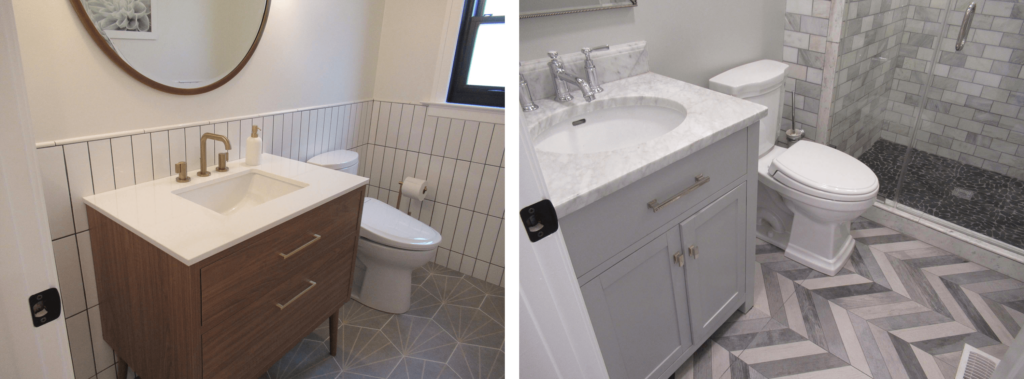
Bathroom Mirrors
Three popular styles of bathroom mirrors are an accent mirror, two matching mirrors and a slab mirror.
- If you have a single sink, you can use an attractive accent mirror as a focal point.
- If you have double sinks, you can choose two matching mirrors with integrated lighting.
- If you choose to cover a wall with a slab mirror, you can create a custom look by having a frame built to match your vanity and by having sconces installed on either side.
Bathroom Lighting and Electricity
Lighting will greatly influence how you will feel about your bathroom. Bathroom designers and contractors suggest including ambient lighting (whole room), task lighting (recessed lighting focused on countertops), and accent lighting (decorative). A prime consideration is for lighting that will allow shadow-free shaving and makeup application. Ask lighting experts for advice.
Designer Recommendations
- Consider mirrors with integrated lighting or fixtures with adjustable LED lighting on the sides of the mirrors positioned so that they lessen or eliminate shadows and unflattering angles on your face.
- Install adjustable recessed lights throughout the room and sufficient task lighting for each dedicated area.
- Install adjustable recessed lights above the tub. These are essential for shaving legs and reading while luxuriating.
- Look for a ceiling fan with an integrated night light or install one on the toe kick or underside of a floating vanity and set it on a sensor.
- Add under-cabinet lighting for elegance and nighttime convenience.
- Add a sun tunnel or skylight to bring unexpected natural light into your bath.
- Add dimmer switches to adjust brightness for all light fixtures. You won’t regret this.
- If you have any art or other decorative pieces to highlight, consider adding accent lights that will focus on those.
- A simple solution to preventing clutter on the countertop is to have electrical outlets placed behind any drawers</b that will store items requiring electricity or recharging (hairdryers, toothbrushes, shavers, etc.). (Remind your home building contractor or remodeling contractor to put a hole in the back of each drawer for the electrical cord, if local code will allow it.)
- Choose a light switch and outlet covers that will blend with your bathroom décor.
Pro Tips For Designing Your New Bathroom or Bathroom Remodel
Building or remodeling a bathroom is a decision-intensive undertaking. With each decision, consider the look, features, durability, ease of use and maintenance requirements, and keep the following pro tips in mind:
- Look at the bathroom from all angles.
- Create a consistent design flow with adjoining rooms such as bedrooms and closets.
- Avoid using too many colors and patterns.
- Provide sufficient counter and storage space.
- Plan so that doors and drawers will not conflict when open.
- Before you purchase a product, make sure it has the features you want, that it is the color or finish you want, and that it contributes to the mood you want to create in the room.
With careful research and decision-making, you can create a new or remodeled bathroom with the look and the features that you will enjoy for years to come.
We hope you have found this article useful and informative, and we appreciate your taking the time to read it.
At Bay Area Design & Construction, we would be pleased to work with you to create the bathroom of your dreams! Our savvy contractor team can help inspire you today.
You can reach us here – Contact Us
Share this post with your friends!
